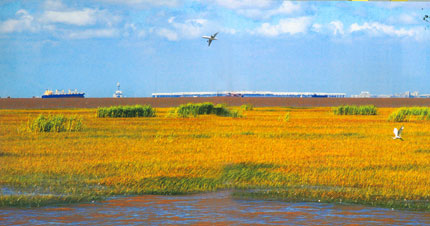Fourth island wetland emerging
Reeds sway in the breeze, gulls dive for fish, crabs scuttle on mudflats, cranes perch in the marsh, and researchers jump from their boats to check the eco-system.
Welcome to the last stop of the Yangtze River which originated from the Qinghai-Tibet Plateau before running into the East China Sea.
It is named Jiuduansha, literally meaning "nine parts of sand" and it's the youngest and largest wetland in Shanghai.
|
Jiuduansha Wetland is a pure paradise for various wetland creatures, including birds, plants, fish and organisms living on the water bed. |
With no interference from humans, it is a pure paradise for various wetland creatures, including birds, plants, fish and organisims living on the water bed. It plays an important role in filtering the water of the Yangtze River in its lower reaches.
Jiuduansha Wetland, located at the mouth of Yangtze River, is a typical estuarine body formed by the combination of land, river and ocean eco-systems. Mud and sand carried by the Yangtze River is the main component of the wetland.
The island didn't rise to the surface until the 1950s, but expanded quickly and became Shanghai's fourth island, the other three being Chongming, Changxing and Hengsha.
The island now covers an area of 528 square kilometers, with 420.2 square kilometers of wetland credited as the largest wetland in Shanghai. Chongming Dongtan has the second largest wetland of 326 square kilometers.
Though named "nine parts of sand," the wetland is mainly comprised of four sand bars - shangsha, zhongsha, xiasha and jiangyanansha. It is said that the "nine" referring to "multiple" in Chinese indicates that the island is comprised of several sand bars.
Just like the other wetlands, Jiuduansha plays a role as the "the kidney of Shanghai," a purifier and filter that protects local resources.
It provides a friendly habitat for creatures like water plants, fish, birds and bottom-dwelling creatures; it purifies water when the river flows slowly through it (toxins will break down while nutrients will nourish plants); it protects the mainland by making room for big tides; it also helps reduce greenhouse effects by capturing carbon elements.
It also plays an important role in supporting scientific search.
Jiuduansha is a young island with no more than 50 years' history. Though expanding fast, it is still in the primary stage of developing as a river mouth bar, according to Sun Ying, president of Shanghai Jiuduansha Wetland Nature Reserve Administration.
Tidal banks are the main physiognomy of Jiuduansha. The vegetation on the island is rather simple, which is typical in new-born lands. There are only 45 families of higher level plants on the island while lower plants like algae are more widely spread.
Most of the higher plants are herbaceous plants, common and widely spread worldwide such as reeds. Scirpus mariqueter, however, is a dominant strain that only grows at the entrance of the Yangtze River and on the coastal mudflat.
Scirpus mariqueter is a pioneer in the revolution of Jiuduansha as it can help accelerate the transformation of mud into land and supports a great diversity of bird species.
The Yangtze River Delta, including Shanghai, was also formed from gathered mud and sand brought down by the river. The delta has already completed its evolution from wetland to land.
But the young Jiuduansha is still in the formative evolution process and can provide a reference for geographic study of the delta and Shanghai.
"Its growth is typically a re-enactment of how Shanghai and the Yangtze River Delta were formed," says Sun. "Research on the geography and climate change on the island can help us know about the land we already live on - including how it was formed and what might happen next."
Located at the intersection of the Yangtze River and East China Sea, Jiuduansha Island is isolated from the mainland and other inhabited islands. So far, there is no human presence on the island, except for some fishermen occasionally boating around it.
 0 Comments
0 Comments








Comments